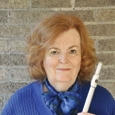Note grouping is phrasing technique in which a performer groups or clusters several notes together in order to express and enhance a musical idea or musical gesture. Note grouping does not affect the printed articulation or rhythm. However, when done properly, there is a slight, almost imperceptible sense of moving ahead or lagging behind rhythmically.
My first exposure to note grouping came from Frances Blaisdell. In one of my first lessons she asked me to play by memory a two-octave scale, with four sixteenth notes per pulse, slurred. Like most band-trained students, I accented the first note of each of the four sixteenth notes staying exactly in time with the metronome. My scale sounded plodded at best.
After I played, she sang a two-octave scale with these words: “I, am going home, to take a bath, to wash the car, to eat some food, to watch T-V, to feed the bird, to walk the dog.” Then she had me play the scale while she sang these words. We continued this duet until we had circled through all the major scales using this note-grouping concept. Of course, when singing, she made octave adjustments here and there so the notes of the scale fit the range of her lovely voice.
Next, Blaisdell wrote out a two-octave scale on a piece of manuscript paper. She told me that the first note was called a solitaire and the next notes were called 2,3,4,1. Above these notes she wrote a small bracket. She said these brackets were think marks and did not affect the articulation or rhythms of the printed music.
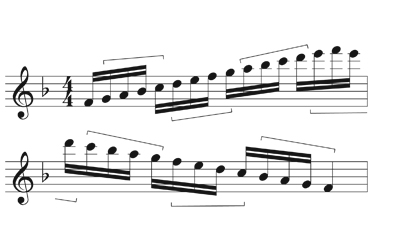
To help me master note grouping, she played the solitaire note and then I played the 2341, and we continued alternating throughout the scale with her playing one group of 2341 and I playing the following 2341. She encouraged me to be as sing songy as possible in order to learn to feel the notes leading into the 1.
At the time I was also working on vibrato control, so she had me repeat this exercise and place a HAH on each of the printed notes and five HAHs on all the 1s. The HAHs were to be done in the larynx or vocal folds, and I was to have no movement in the abdomen or chest. If I sensed any movement other than in the larynx, I was playing too loud as HAHs were to be executed pianissimo. She reminded me that as I ascended up the scale, the aperture (opening in the lips) was to become smaller, and as I descended down the scale, the aperture was to become larger. In my future lessons, she placed brackets in my solo repertoire and instructed me to blow or send my energy to the 1.
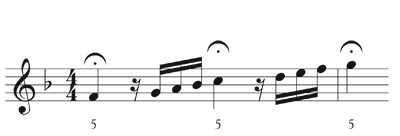
She said that she had learned this technique from her studies with William Kincaid, the father of the school of American flute playing, professor of flute at the Curtis Institute, and principal flute of the Philadelphia Orchestra. While Blaisdell had been principally a Georges Barrère student, she told me she always played for Kincaid several times a year to be sure that everything in her playing was going well.
A couple of years later I began my own studies with William Kincaid. My lessons (and I think my student colleagues’ too) began with whistle tones from a low C and then a C#. Once I was able to play up and down the harmonic series in whistle tones, I was to isolate one of the higher pitches and sustain it for as long as possible. This exercise was to warm up the small muscles surrounding the aperture and work on playing with a very slow air stream. Next I played an exercise that he sometimes called the Praeludium, the V7 warmup, or vocalise. (Click here for a copy of this exercise.)

I was to play the vocalise with the 1, 2341, 2341, 2341 note-grouping pattern that I had previously learned from Blaisdell. Kincaid always had me start this on a low G which is the root of the V7 chord in the key of C major. I then proceeded to play the vocalise on each of the ascending chromatic steps until I ran out of notes in the fourth octave. He reminded me that note grouping was a mental exercise and should not affect any articulation marks or written rhythms. Rather than the clever set of words that Blaisdell had taught, I was to mentally think 1, 2341, 2341 etc.
Kincaid loved etudes as did his students Joseph Mariano and Julius Baker. He was especially fond of the ones by Joachim Andersen (1847-1909, Danish flutist, conductor and composer). These books each have 24 exercises that progress through all the major and minor keys around the circle of fifths. Kincaid taught the exercise books in the following order: Op. 33, 30, 63, 15, 60. Even though I had studied several of these books before, Kincaid had me begin with Op. 33. Kincaid assigned six etudes for the next lesson (which was two days in the future). He marked the grouping pattern on the first notes of each etude.

Since I had previously studied note-grouping with Blaisdell and remembered how she had also had me practice the HAH exercise on the scales, I used this technique in learning and perfecting the exercises. Not only did I practice HAHs, but repeated the process using T, K, and TK. I adapted this exercise so that I could practice counted or measured vibrato by placing five vibrato cycles on all the ones. I played this exercise tennis or ping pong style (alternating playing the 2341 groups with another flutist.) By the time of my next lesson, I knew these exercises quite well. My articulation and vibrato skills were improved too.
Unfortunately for Kincaid, but fortunately for me, I had already begun to have questions about the 2341or “forward flow” concept. (In the 1980s for the sake of ease and clarity in teaching, I named the 2341 concept forward flow.) I had been studying during the school year with Joseph Mariano at the Eastman School of Music. Mariano told me about an interview of the world-famous cellist Pablo Casals (1876-1973). The interviewer had asked Casals how he started his day. Casals replied that he got a cup of coffee and then retreated to his practice shack to play one of the Bach cello suites. The interviewer remarked that Casals had recorded these six suites several times already and had also performed them numerous times around the world, so what was there left to practice? Casals responded, “Oh, but I see something new in them every day.” Then Mariano asked me the big question “What do you think Casals meant?” Immediately I understood that my early experiences with note grouping were just the beginning, and as I grew and matured as a musician, I would see new ways of grouping the notes in continually varying patterns.
Mariano often mentioned that flutists should phrase as if the music was bowed (as in string technique). He told me that when playing in orchestra; I should pay attention to the concertmaster and follow his bowings. I realized that I knew little about string bowings, so I enrolled in a year-long MusEd violin methods class taught by David van Hoesen, an author of several string method books. I learned that the bow moves in two ways – down bow and up bow. A down bow starts with the right hand close to the player’s nose, and the up bow starts at the tip with the right hand away from the player. Generally notes to be taken down bow start on the beat and notes to be taken up bow start off the beat. Due to the construction of the modern bow, down bow notes naturally become softer as the right hand becomes farther away from the player, and up bow notes naturally become louder as the player’s right hand comes closer to the player.
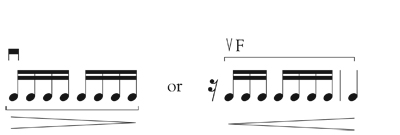
After taking this course and discussing my findings with Mariano, I began to mark my music with the down and up bow icons. From my violin studies, I realized that I could take many notes on a down or up bow, not just 2341. So for my lesson with Kincaid, I had marked the bowings as shown below.
After four bars, Kincaid stopped and asked me what I was doing. I had obviously begun with the 1, 2341, concept, but in bar 3 had changed to a 12345678, 12345678 grouping pattern, followed by a 1234, 1234, 12345, 6781 pattern. I explained (not very well) that I did not feel the sixteenths in measure 4 as going by in the 2341 patterns. After asking me about my phrasing in the Andersen Op. 33, No 1 study, Kincaid tried my bowings. He sounded great as always, but, he turned to me and said, “Think about it some more.” And, I did. I also found that adding an F or a B after the up bow icon reminded me whether I should go forward (F) or back (B) on the up bow.
John Krell’s brilliant book Kincaidiana discusses Kincaid’s theories at length. Looking back I now realize that most of the music played during Kincaid’s tenure in the Philadelphia Orchestra was from the Romantic period. If the orchestra ever played anything from the Baroque era, it was one of Leopold Stokowski’s Romantic transcriptions of a Prelude and Fugue. If music of the Baroque or Classic eras were programmed, it was played in the Romantic singing style. Based on the repertoire Kincaid was performing, his 2341 worked well for him. A performing musician today is cognizant of the research into early music and knows that dancing music primarily incorporates the 1234 groupings. All music uses some of each, but Romantic music predominately uses the 2341 grouping. Musicians should be able to quickly and easily shift from the 2341 to 1234 with ease and understanding.
Each of my teachers taught some variant of these basic ideas. Julius Baker referred to the first note as “the note that sets tonality” rather than as a solitaire. Rather than using brackets, Joseph Mariano used a curvy line between the groups. I predominately use the curvy line (see below) too because I think it subconsciously helps me remember to keep the air stream going.
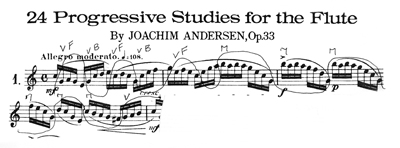
As you work with these ideas personally or with your students, remember two wonderful quotations from cellist Pablo Casals, “the art of interpretation is not to play what is written” and “the heart of the melody can never be put down on paper.”
